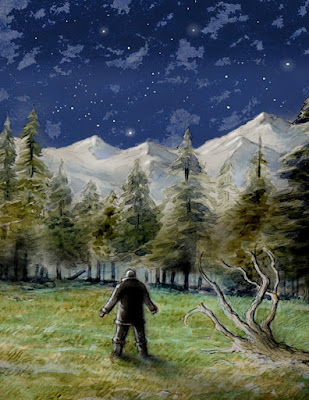“I can remember a forest and I looked to my left to see a tall dark shape standing 20 feet away in the trees.
“At first I thought it was a man but then it came towards me.
“He must have been huge, some eight to ten feet tall, and really wide."
The man in question was driving by at 60 mph, and therefore not in a position to give a more detailed description. A rationalist/sourpuss might remark that judging the size of anything briefly glimpsed in the dark is tricky, which is why we keep hearing about mysterious big cats. But let's assume that an eight-to-ten feet tall entity is out there, near Fife. What might it be?
Well, if it's straining credulity to believe there's a Beast of Bodmin, or a Surrey Panther, the Bigfoot of Tayside really can't be credited. At least, not as a legitimate species of primate. But what if it's a visitor from a parallel universe? This was the view advanced by
John Keel, a UFO researcher - and author of
The Mothman Prophecies - who concluded that weird visitants of all kinds were popping into our world from some other, equally real, parallel reality.
The obvious problem is finding actual evidence of any parallel reality, monster-infested or otherwise. I would love to believe that a world of vampires, Bigfoots/Bigfeet, werewolves, unicorns, dragons, and such exists right alongside my own. Such a parallel universe (or whatever you call it) would also explain ghosts. Oh, you've seen the Weeping Nun of Bognor Regis? Well, in one particular parallel universe Bognor Regis is pretty much Weeping Nun Central. For some reason.
Like all 'theories' that explain everything, the parallel universe notion really explains nothing. But that's the clever part. The fact that we have precisely no DNA from Bigfoot, or Nessie, or the Yeti, or the Ogopogo, is to me evidence that they don't exist. But if you desperately want to believe in such creatures you can claim they don't hang around in our universe long enough to leave any genetic material.
There have been a few fictional treatments of this idea. The earliest I know of was by the 'hard sf' writer Larry Niven in his stories about Hanville Svetz, collected originally in
The Flight of the Horse (more recently in
Rainbow Mars). Svetz is a state functionary in a far-future world where pollution has killed off all plants and animals except those preserved in parks and zoos.
The despot of the day sends Svetz back in time to nab various historic creatures, artefacts etc, but it emerges that the time machine can't function in our universe because it would generate the usual paradoxes. Instead it slews about all over various parallel realities where Svetz encounters mythical beings. Thus instead of a horse he brings back a unicorn, and his ostrich egg hatches out the Roc of Scheherazade's tales.
This is rather different from the 'other dimensions' routinely used by Lovecraft and his many disciples. These, so far as I can tell, bear no relation to our reality, and of course the beings in them are not your regular monsters of folklore.
Another, related, idea is used by (among others) the sf writer Clifford Simak in his novel
Out of Their Minds. Here a newsman (Simak was a reporter) stumbles across a world of mythical and fictional beings, essentially brought into existence by human imaginings. Not a parallel world, but one existing in pockets of our own.
The main problem with the parallel universe story is that it's too easy to invoke. Harry Potter? Indiana Jones? The Great Old Ones? A Thousand Year Reich victorious in WW2 and going on to conquer space? All feasible in their own universes. Perhaps for this reason parallel universe stories remain an obscure sub-genre of science fiction, with a few remarkable exceptions such as
The Man in the High Castle.

















